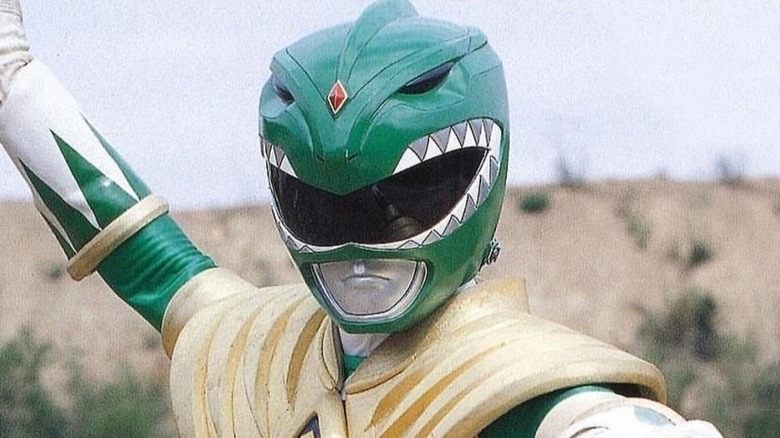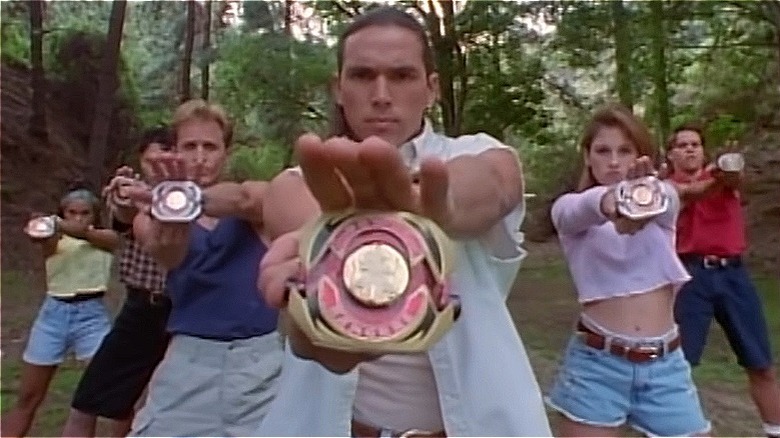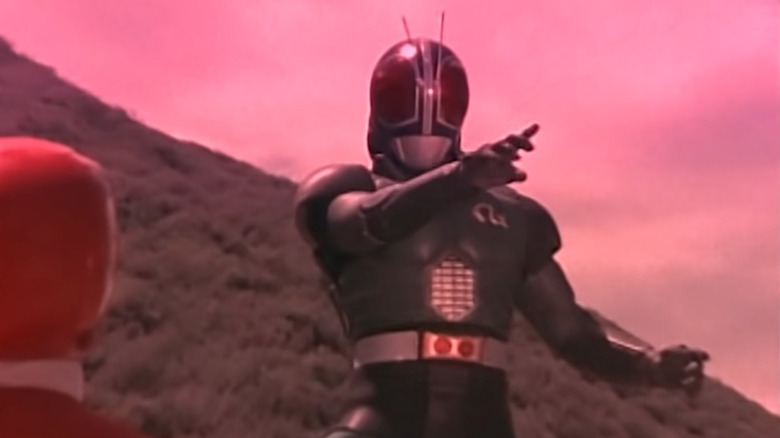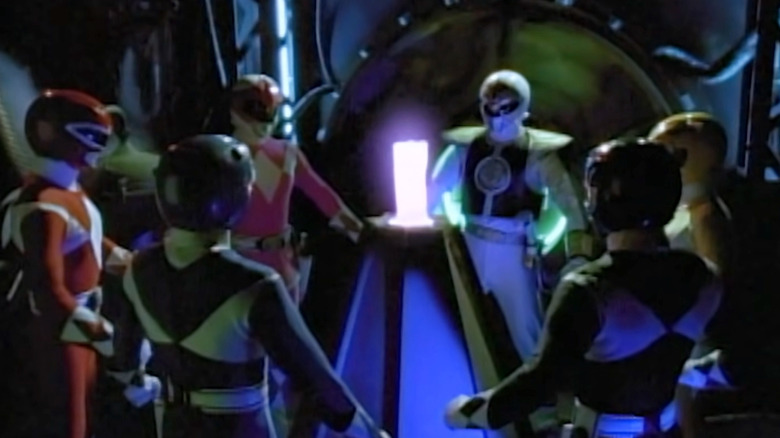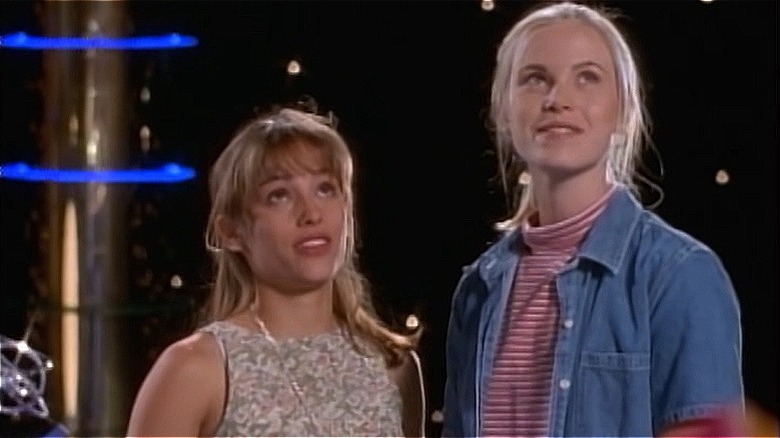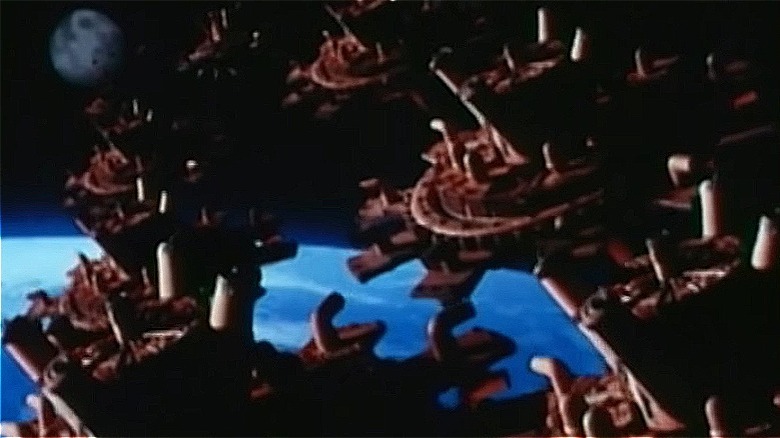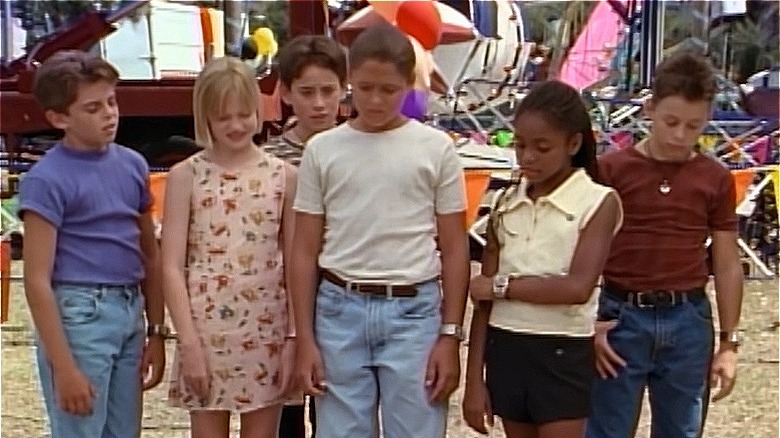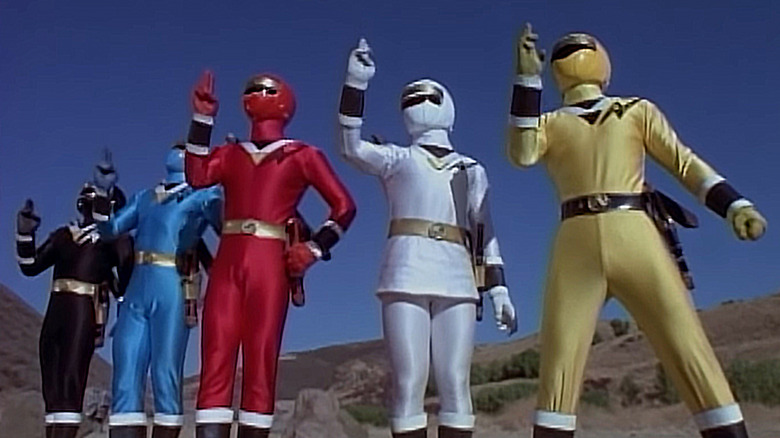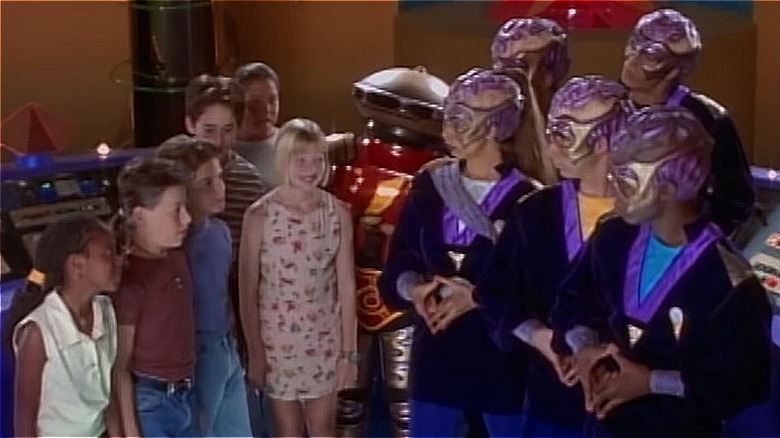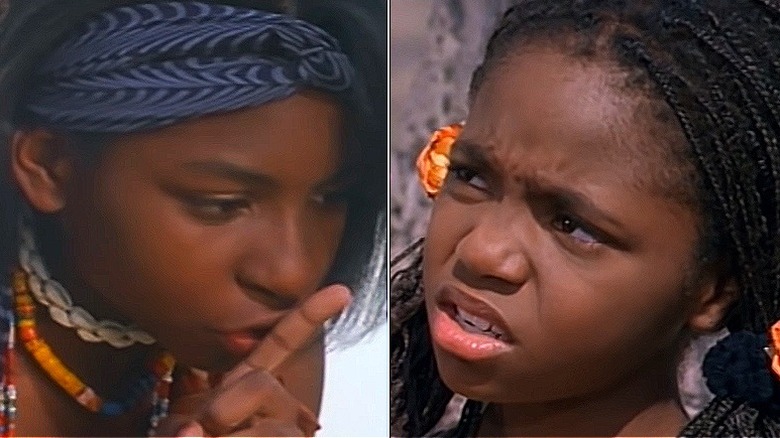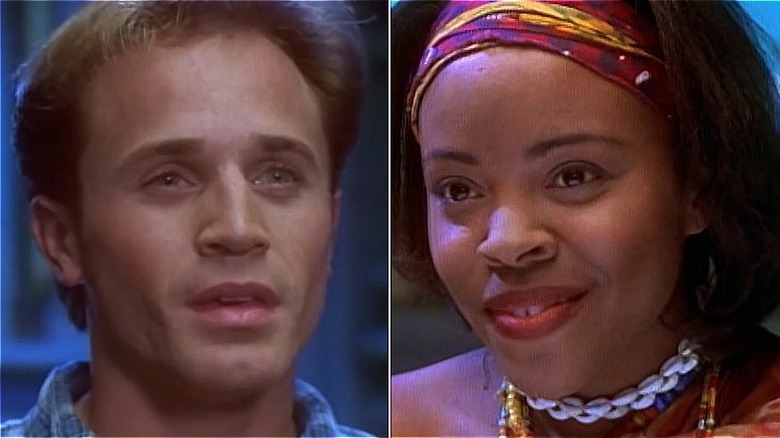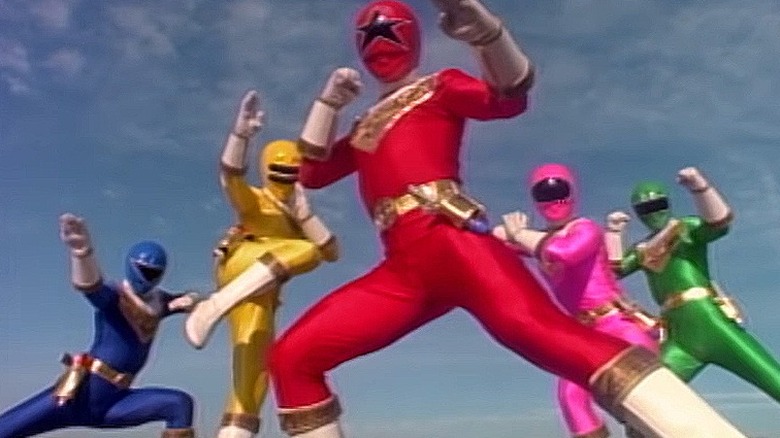The Ending Of The Original Mighty Morphin Power Rangers Series Explained
Most kids who watched "Mighty Morphin Power Rangers" when it first aired probably didn't care about the production side of things, but there's been a lot written about how this now-iconic show came about through an ingenious cost-cutting measure. On the surface, it appears to be an English-language series about American teenagers protecting their hometown from the evil space sorceress Rita Repulsa. However, whenever our teens "morph" and go off to fight a monster, viewers are actually seeing re-dubbed footage from "Kyōryū Sentai Zyuranger," a Japanese tokusatsu show that is, in its native country, just a small part of the much larger "Super Sentai" franchise.
From a business perspective, it was a brilliant idea for a low-cost television series, and it ended up being a huge success. Unfortunately, the show eventually became a victim of that very idea, because this approach contained a fatal flaw. By the time the show reached its third season, this flaw had grown into a huge problem, and it impacted the ending of the series in a massive way. Buckle up, because we're taking a deep dive into the ending of the original "Mighty Morphin Power Rangers."
The problem and the solution
The aforementioned issue relating to "Mighty Morphin Power Rangers" is that, unlike most television shows in America, the Japanese series "Super Sentai" does not tell a single unified story across its many seasons. Instead, it does a sort of soft reboot at the end of each season, switching to a new team with new characters and new costumes each year. Although "Mighty Morphin Power Rangers" took a great deal from "Super Sentai," this was one idea that it didn't replicate. Instead, "Mighty Morphin Power Ranger" kept the same story going from season to season, with the same characters and — vitally — the same costumes.
The downside of this decision was that, by the end of the first season, the show had effectively run out of usable footage from "Zyuranger." Producers addressed this in two ways: By incorporating some limited footage from other seasons of "Super Sentai," such as "Gosei Sentai Dairanger," and by creating some original fight scenes. However, this essentially defeated the entire purpose of making a show like "Power Rangers," which is that all the expensive and complicated bits were already made by someone else. In order for the show to continue, it would need to find a more permanent solution. The only way forward was to follow suit and start over.
A three-part backdoor pilot
Most "Power Rangers" seasons begin with the arrival of a new big bad who our heroes will have to battle repeatedly over the course of the coming season. At first, it seems like Season 3 is starting the same way, with the three-episode arc "A Friend in Need." Our heroes learn that a planet called Edenoi is under attack from the evil space warlord Count Dregon. When the Rangers arrive there, they meet Prince Dex, a skilled warrior who can transform into a suit of black armor with a bug-like helmet. The Rangers and Dex agree to team up and fight Dregon together. In the end, Dex learns that Dregon has now set his sights on Earth, so he vows to travel there to become its new protector.
It looked like this was going to be the main story of "Power Rangers" Season 3 — Dex and the Power Rangers battling Dregon — but that wasn't the case. After this episode, Dex and Dregon are never seen again, at least not on this show. That's because these episodes were actually a three-part backdoor pilot for a new Saban series called "Masked Rider." Just like "Power Rangers" used footage from "Super Sentai," "Masked Rider" would use footage from the iconic tokusatsu franchise "Kamen Rider." In retrospect, this was the first sign that the series was becoming less interested in maintaining the status quo of the Power Rangers and more interested in setting the stage for what was to come.
The Zeo Crystal
The story of the end of "Mighty Morphin Power Rangers" begins with the three-part episode "Master Vile and the Metallic Armor," a title which really buries the lede in terms of what's actually going on here. Yes, the Rangers meet a new recurring villain, Master Vile, and yes, they also get a new power, the aforementioned Metallic Armor. But by far the most important thing that happens here is the introduction of the Zeo Crystal, probably the most important magical MacGuffin in "Power Rangers" history.
When the story begins, the Rangers' mentor Zordon tells them that Master Vile is searching for the Zeo Crystal, one of the most powerful forces in the universe. The crystal is hidden in a cave on Earth's moon, but it's protected by a forcefield that will prevent anyone evil from touching it. Fearing that Vile might somehow find a way through this forcefield, the Rangers go there to recover it themselves. However, this ends up being a terrible decision, because after they've removed the crystal, Master Vile defeats the Rangers and takes it from them. He then uses the crystal's power to terrorize the people of Angel Grove.
Eventually, the Rangers manage to steal the Zeo Crystal back and stop Vile's attack. In order to keep the artifact out of evil hands once and for all, the Rangers shatter it into five pieces and toss those pieces into a "time hole," scattering the shards across spacetime so they can never be reassembled. Or can they? Let's put a pin in that for now.
A different shade of pink
Throughout Season 3, there are many events which signal that times are changing for "Power Rangers," including the departure of a character who had been (excuse the pun) the heart of the show since the very beginning: Kimberly Hart, the Pink Ranger, played by Amy Jo Johnson. This wasn't the first time a Ranger had left the show. During Season 2, Austin St. John, Walter Emmanuel Jones, and Thuy Trang (the original Red Ranger, Black Ranger, and Yellow Ranger) all quit due to contract disputes. Their departures were handled rather clumsily, with multiple episodes featuring the characters only in their face-concealing helmets. This time, things were handled much more gracefully.
In "A Different Shade of Pink," Kimberly, a skilled gymnast, is training to compete in the trials for the Pan Global Games (this world's Olympics). When her intense training starts to interfere with her Power Ranger duties, Kim realizes she can't do both. She has to choose, and with the full love and support of her team, she chooses gymnastics, transferring her powers to her friend and classmate Kat Hillard (Catherine Sutherland). Kat, for the record, was originally introduced as a villain who could shapeshift into a cat, but then she was redeemed and joined the side of good. With Kim's departure, now there was only one original Power Ranger still remaining on the team: Billy Cranston, the Blue Ranger. His days were also numbered.
The Zeo Serial
One way that Season 3 foreshadows "Power Rangers Zeo" occurs not in the episodes themselves, but in the segments around them. In earlier seasons, the show would begin with a brief preview of the upcoming episode. In Season 3, however, some of these segments were replaced with what has become known as the "Zeo Serial," a series of cryptic and moody scene fragments which take place at some unspecified point in the future.
The first few shorts follow a group of scientists who've detected a disturbance in the Earth's atmosphere. Later segments show Lord Zedd and Rita celebrating, thrilled to have finally defeated the Power Rangers for good. Other shorts follow the citizens of Angel Grove fearing the arrival of a new force of invading aliens known as the Machine Empire. The last few shorts finally reveal the rulers of the Machine Empire: King Mondo and Queen Machina, a pair of evil robots who gloat about how unprepared Earth is for their arrival. Throughout all these shorts, the Power Rangers themselves are nowhere to be seen.
Nowadays, the Zeo Serial is a somewhat forgotten part of Power Rangers history. One reason why is because the shorts are of dubious canonicity, slightly contradicting what actually occurs at the beginning of "Zeo." Another reason is that they're not officially available on any streaming services. They were, however, released as a bonus feature on the "Power Rangers" Season 4-7 DVD box set.
A cliffhanger ending?
If you look up "Power Rangers" on Netflix, you'll see that Season 1 has 60 episodes, and Season 2 has 52, but Season 3 only has 33. Also, the final episode of Season 3 is listed as "Rangers in Reverse," which ends on one heck of a cliffhanger.
In this episode, Master Vile plans to use an artifact called the Orb of Doom to de-age everyone on Earth a decade or so. He believes that, if he can transform the Power Rangers from "teenagers with attitude" into harmless little children, no one will be able to stop him, and at the end of the episode, shockingly, his plan succeeds. Time is reversed, the Rangers become children, and, as they stand there, facing the forces of Master Vile, they realize they are hopelessly outmatched. And that's the end — the end of the episode, the end of the season, and the end of "Mighty Morphin Power Rangers."
At least, that's what some sources would have you believe. In truth, this is not the end of "Mighty Morphin Power Rangers." There's still 10 more episodes to go, but they aren't on Netflix, and nowadays, they can be a little tricky to find if you don't know what you're looking for.
The arrival of the Alien Rangers
The story of "Mighty Morphin Power Rangers" does indeed get a proper conclusion in a 10-episode arc called "Mighty Morphin Alien Rangers." Although these episodes weren't available on streaming services anywhere for a while, nowadays they can now be found on the official Power Rangers YouTube channel, where they're given the label "Season 3A."
In this storyline, our heroes are still stuck as children, so they ask for help from another group of Power Rangers — the Alien Rangers from the planet Aquitar. While the kids search for a way to undo what's been done to them, the Alien Rangers take over their duties, keeping Angel Grove safe. Fans of "Super Sentai" might recognize these newcomers' costumes as the ones from "Ninja Sentai Kakuranger." As such, whenever the Alien Rangers go off to fight a monster, the show switches to re-dubbed footage from "Kakuranger." One probable behind-the-scenes reason for the introduction of the Alien Rangers is that it allows the show to return to its original cheaper model for a bit, switching to "Super Sentai" footage whenever a fight breaks out.
In order to return our heroes to their proper ages, Billy the Blue Ranger does what he always does — he creates a new invention. It's called the Regenerator, a device that runs on energy produced by the Power Coins, the source of the Rangers' powers. Billy uses the device on himself, restoring him to his proper age, but before he can use it on anyone else, the Regenerator is stolen by the villainous Goldar, who then removes the Power Coins and — in a gut-wrenching twist — crushes them all in his bare hands. Now, even if the Rangers are able to return to their proper ages, their superpowers will still be gone forever.
The quest for the Crystal
At this point, there's only one power source left that can restore the Earth to normal. That power source is the Zeo Crystal, but, as you might recall, the Rangers broke the Zeo Crystal and scattered its pieces all across spacetime. Zordon tells the Rangers that in order to get the crystal back, they'll need to travel to the five different places and times where the pieces ended up. Since there are six Rangers, but only five crystal shards, Billy stays behind while the younger rangers all leap into a time vortex, heading off to an uncertain fate. Before they depart on their quest, the White Alien Ranger Delphine gives them a hint as to what awaits them, telling the kids that "the spirits of your ancestors will show you the way."
Each kid then arrives in a different point in the past, in a different part of the world that connects to their heritage. Over the next few episodes, each goes on a quest to retrieve their respective piece of the Zeo Crystal. Rocky DeSantos finds his crystal shard in a volcano in Mexico; Adam Park gets his after meeting an old wise man in pre-modern rural Korea; Kat Hillard gets her crystal after a surreal adventure in the Australian Outback; Tommy Oliver finds his near a Native American village somewhere in the American Southwest. For the record, the character Tommy Oliver is stated to have Native ancestry, even though his actor, Jason David Frank, does not.
From Aisha to Tanya
The most noteworthy chapter in this saga is the one featuring the Yellow Ranger, Aisha Campbell (played by Karan Ashley as a teenager and Sicily Sewell as a preteen). Aisha arrives in the African savannah, and after being briefly menaced by some stock footage of a lion, she's rescued by a girl named Tanya Sloane (Khanya Mkhize), who it turns out is also originally from America. She explains that her parents were "explorers," but after they mysteriously disappeared, she was taken in by some local villagers.
Tanya tells Aisha that a mysterious plague is affecting the animals here. Aisha, who works at an animal shelter, offers to help however she can. Because of this, Aisha is reluctant to return home after locating her crystal shard. Eventually, the two girls decide that the best thing to do is to switch places. Tanya will return the crystal shard to Zordon, while Aisha will remain in Tanya's village to help stop this strange sickness. Tanya then travels forward in time to the present, and, with the crystal re-assembled, everyone on Earth instantly ages by ten years. This means that Tanya becomes a young adult, now played by actress Nakia Burrise.
You probably have numerous questions. If Aisha traveled into the past, does she now live in that time period? If Tanya's from the past, was she also de-aged in her own time, and now she's been returned to her proper age, or is she really supposed to be a preteen, and she's just skipped a decade of her life? The show offers no answers, and if you're feeling confused, you must be new here. The answer to all these questions is simply: This is "Power Rangers." It's best not to think about it too hard.
Billy steps down
The Zeo Crystal has been reassembled. The broken timeline has been restored. Our powerless kid heroes are about to become superpowered teens once again, but there is still one problem remaining: the Zeo Crystal only has five pieces, and there are six Rangers on the team. Someone is going to have to give up their spot. At first, Tanya volunteers, since she was never a Power Ranger to begin with, but then Billy offers her his place on the team. He explains that, in the time that he spent without his powers, he's learned that he's much more effective working in the Command Center in a support capacity than he ever was fighting monsters on the frontline.
Tanya accepts Billy's offer, officially becoming the Yellow Zeo Ranger (she would grow into a rich and interesting character over the next season and a half, getting a whole arc that filled in the gaps regarding her missing parents). And with that, the last original Power Ranger departed. Even though this moment occurs during the first episode of "Power Rangers Zeo," it's arguable that this is the actual moment that "Mighty Morphin Power Rangers" — both the show and the team — finally came to an end.
It's handled better than most previous exits, though the reasons behind Billy's exit were anything but cordial. In the years since his departure, Blue Ranger actor David Yost has revealed that he walked away from the show after growing tired of homophobic abuse directed at him by producers, writers, and directors. "Basically I just felt like I was continually being told I was not worthy of being where I am because I'm a gay person," he said during a 2010 interview.
Power Rangers Zeo and beyond
From here began the next chapter in "Power Rangers" history. We were introduced to new heroes, new villains, and we got a brand new theme song. Most importantly, the creators could start using footage from a new season of "Super Sentai," this time mining scenes from "Chouriki Sentai Ohranger."
Though a fresh start in many ways, "Power Rangers Zeo" was still the same show it always had been. Much of the supporting cast remained — the Rangers' allies Zordon and Alpha 5 were still around, as were their favorite frenemies Bulk and Skull. Zedd and Rita were no longer the show's primary villains, but they were still hanging around as minor comic relief antagonists. And although David Yost had left the show to look after his mental health ("I was worried that I might take my own life," he said when he revealed that he was repeatedly belittled for his sexuality), Austin St. John, the original Red Ranger, came back into the fold. His character Jason re-joined the team, now as the Gold Ranger.
The much harder reboot wouldn't fully arrive until two years later, when "Power Rangers in Space" finally delivered an epic and bittersweet conclusion to the story that "Mighty Morphin Power Rangers" began. After that point, "Power Rangers" would start resembling "Super Sentai" much more closely, telling entirely self-contained stories with a brand new cast of characters each season.
If you or anyone you know is having suicidal thoughts, please call the National Suicide Prevention Lifeline at 1-800-273-TALK (8255).
